When discussing the topic of Building Information Modelling (BIM), people often ask me, “So this BIM thing you describe, is it a shrink wrapped software solution?” Let me start by saying “you can’t buy a box of BIM!”
BIM is not a software solution; it is a process, underpinned by technology and collaborative working. In many instances the use and reuse of data throughout the lifecycle of a construction project is not used efficiently. Much information is wasted due to mistrust, information not being complete, lack of process and standards, as well as a lack of understanding of what data is available. The BIM process attempts to maximise the return on investment by defining a fluid flow of data use. Underpinning this is a clear strategy to ensure the delivery of information and data is defined in the manner which is usable throughout the whole project life cycle. This more complete information stands to improve the quality, efficiency and sustainability of buildings delivered to clients.
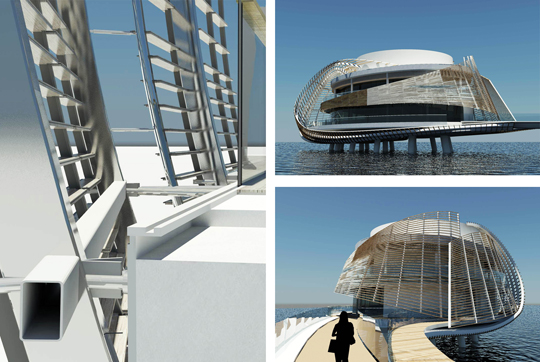
JWTR, Dubai – Revit rendering of the fabrication model
Implementation
Implementing BIM requires a fundamental shift in working practices compared to the traditional design and collaboration process. BIM is about changing the workflow for the future. It requires effort and leadership to move teams forward from established tried and tested traditional delivery methods. In many ways it’s about changing hearts and minds, moving people out of their comfort zones into new ways of working and thinking.
HOK is a world leader in utilising BIM. We are committed to using BIM on all our projects and our success is thanks to strong leadership at all levels of the company. Our CEO, Patrick MacLeamy, was the founder of the IAI (International Alliance for Interoperability)/ buildingSMART international and his industry vision, leadership and passion for BIM is unparalleled.
Patrick MacLeamy also developed the concept of “shifting the effort,” otherwise known as the MacLeamy Curve. The MacLeamy Curve diagram highlights that the further you are through the design process, the higher the cost of design change. This also has a direct correlation with potential project delays, wastage and increased deliver costs. For this reason the BIM process draws the project stakeholders together earlier so that the individual parties can coordinate their design input, encouraging a more integrated approach to project design and delivery.
buildingSMART: An approach to BIM and IPD
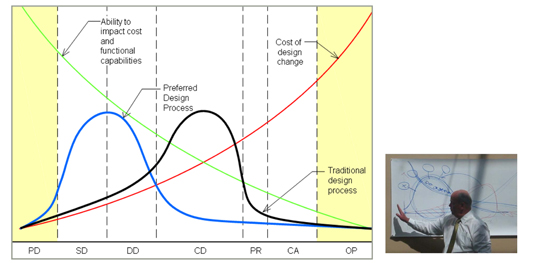
”MacLeamy Curve” Patrick MacLeamy CEO
At HOK we’re passionate about great design, and we see BIM as a better way to design and construct buildings. It allows us to test the efficiency of our designs quickly and easily, helping to create verifiable life cycle costing, and enables us to give clients unprecedented insight into how a building will work in reality long before construction starts. BIM also has the potential to allow architects to expand their business by allowing us to assist in establishing a connection in the process for operations, maintenance, facility management and property management. Often all the hard work that is undertaken during the design and construction stage is lost once the building is complete and the keys are handed over to the client. In many cases the architect understands the building intimately, maintaining that connection with client and the building throughout its lifecycle is an opportunity, which if harnessed should help inform the next design iteration; one might call this BIM360, true building lifecycle management.
So how and where did HOK start its BIM journey?
The use of new technology has always been fundmental to HOK’s approach. In the mid 1980’s HOK developed its own CAD solution called DrawVision. As AutoCAD became the defacto industry standard for 2d CAD, HOK later migrated to AutoCAD as its standard delivery platform. But it wasn’t until the release of Autodesk Architectural Desktop (ADT) that HOK then started to venture into the world of Building Information Modelling. Connecting CAD data to databases is something HOK had been doing for a number of years, but ADT introduced smart 3d architectural objects which would display equally well in 2d and 3d as well as allowing database connectivity. Early on ADT was deployed on a number of projects within the business, but as a firm-wide BIM solution, it required considerable customisation to meet the required BIM goals. Not that it didn’t deliver, far from it, BARTS in Royal London Hospital is a case in point. When complete in 2012, the Royal London Hospital will be the largest new hospital in the UK. The 6,225 rooms across 120,000 sqm, 905–bed facility will provide London's principle trauma and emergency centre. ADT was fundamental to the successful delivery of the project and HOK has won a number of awards for its ground breaking use of Building Information Modelling on this project.
Never the less, it was felt that a better technology was required for Design Authoring which would allow us to truly deliver the BIM vision that the business was striving for. So in 2006 and with the support of HOK’s Advance Technology Group (ATG), various different BIM technologies were reviewed. After this initial research and a successful pilot project, the ATG team believed that Autodesk Revit could provide the potential solution, a view reinforced by feedback they received from two day workshops which were held in each HOK office to gather user feedback on Revit. The end result was that whilst Autodesk Revit did have some limitations, overall from a technology and strategic standpoint, it met with HOK’s Design Authoring objectives and later that year the HOK board of directors mandated the use of Autodesk Revit on all new projects. At the same time HOK unveiled its HOK buildingSMART process.
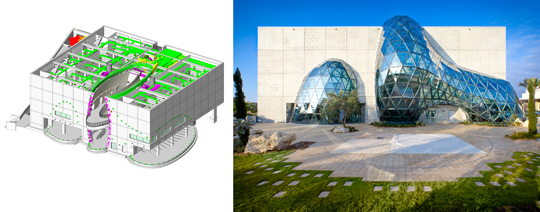
Dali Museum, Florida opened January 2011
So what is HOK buildingSMART?
HOK buildingSMART is an approach to design that leverages 3D modelling, concurrent analysis and integrated delivery practices. It enables project teams to collaborate on virtual models, test ideas, optimize building performance and coordinate work before beginning procurement or construction begins. At HOK we describe HOK buildingSMART as...
“An innovative way of working in a virtual environment using intelligent objects in a model server so that design, construction, operation and sustainability are tested and optimized before work commences on site”
At the heart of buildingSMART is the model, which is developed using the Autodesk Revit platform. The key components which map the buildingSMART business platform include:
- Model Input
- Design Parametrics
- Performance based design
- Quality and Delivery
- Specification
- Fabrication Workflows
- Integrated Project Delivery
- FM
HOK has and continues to review all the various technologies that it uses; these technologies have been mapped to the key buildingSMART objectives listed above, but more importantly have been aligned with our quality procedures. Inevitably gaps where discovered to allow the effective use and reuse of data; interoperability of data continues to be one of the biggest challenges for any firm looking to use BIM centric workflow. Where gaps have existed, extensive research has been undertaken to look for new and emerging solutions which allows us to connect the buildingSMART work stream objectives together.
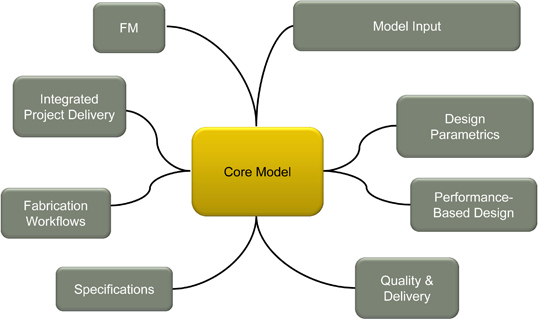
Mapping the buildingSMART business platform
Measuring Quality
As they say with any data system, if you put rubbish in, you will get rubbish out. This is no different with BIM. Understanding your goals and objectives as well as the required deliverables is extremely important, to ensure maximum efficiencies for the client. Also, a clear understanding of how you will collaborate with others, and what technologies will be used, needs to be well–defined.
At HOK this is achieved by capturing all this essential information in Design Team Project Execution Plan (PxP). The primary goal of the PxP is to define which BIM uses will be implemented on each project to achieve the project goals. For each BIM use selected, the following must be decided:
- Who will be performing the BIM use?
- What data will be shared and how will it be shared?
- How will model authorship be assigned?
- What are the criteria related to each BIM use?
Ensuring everybody knows what to expect from BIM and when to expect it is extremely important. The PxP is a fundamental component to ensuring our buildingSMART objectives are met and is why we have also connected this document to our internal quality assurance process. Any potential obstacles that do exist can be resolved in one form or another with good planning; but we believe it is extremely important to:–
- Ensure the whole design team are aligned to the BIM strategy
- Ideally ensure the design team agree to a common software platform
- Allow the design team to set clear BIM goals and expectations (BIM isn’t a panacea)
- Clearly define the deliverables
- Ensure required supply chain input is available
- Involve the contractor as early as possible
- Ensure that roles and responsibilities are clearly defined, particularly if the model is to be shared or inherited by others
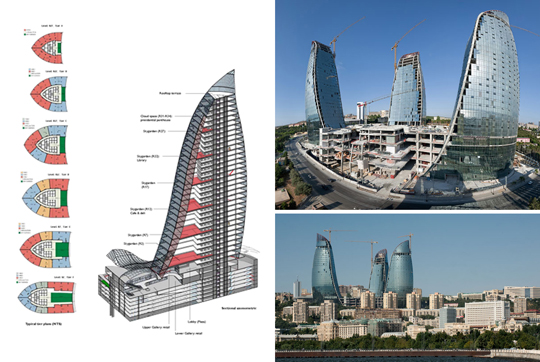
Baku Flame Tower, Azerbaijan, designed & conceived using BIM
The future
Most users understand immediately the benefits to be derived from BIM. Needless to say, BIM does require a considerable amount of upfront investment in software, hardware and staff training. But fundamentally for BIM implementation to have a positive outcome, it needs top down leadership. Only through this leadership and the want to do things different will BIM execution be successful.
BIM is a collaborative approach to working, which requires multi–party input and integrated data sharing, where project decisions are inherently made in the interests of the project and therefore the client. At HOK we continue to push the boundaries of our BIM implementation recognising that the internet and cloud computing offer us new as well as truly global collaborative ways of working.

